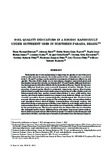Use este identificador para citar ou linkar para este item:
http://www.alice.cnptia.embrapa.br/alice/handle/doc/986197| Título: | Soil quality indicators in a Rhodic Kandiudult under different uses in northern Parana, Brazil. |
| Autoria: | KUWANO, B. H.  KNOB, A.   FAGOTTI, D. S. L.   MELÉM JÚNIOR, N. J.   GODOY, L.   DIEHL, R. C.   KRAWULSKI, C. C.   ANDRADE FILHO, G.   ZANGARO FILHO, W.   TAVARES FILHO, J.   NOGUEIRA, M. A.   |
| Afiliação: | BIANA HARUMI KUWANO, UEL; ADRIANA KNOB, UEL; DÁFILA SANTOS LIMA FAGOTTI, UEL; NAGIB JORGE MELÉM JÚNIOR, UEL; LEANDRO GODOY, UEL; RAQUEL CÁTIA DIEHL, UEL; CRISTINA CÉLIA KRAWULSKI, UEL; GALDINO ANDRADE FILHO, UEL; WALDEMAR ZANGARO FILHO, UEL; JOÃO TAVARES FILHO, UEL; MARCO ANTONIO NOGUEIRA, CNPSO. |
| Ano de publicação: | 2014 |
| Referência: | Revista Brasileira de Ciência do Solo, Viçosa, MG, v. 38, n. 1, p. 50-59, 2014. |
| Conteúdo: | ABSTRACT: Sustainable use of soil, maintaining or improving its quality, is one of the goals of diversification in farmlands. From this point of view, bioindicators associated with C, N and P cycling can be used in assessments of land-use effects on soil quality. The aim of this study was to investigate chemical, microbiological and biochemical properties of soil associated with C, N and P under different land uses in a farm property with diversified activity in northern Parana, Brazil. Seven areas under different land uses were assessed: fragment of native Atlantic Forest; growing of peach-palm (Bactrys gasipaes); sugarcane ratoon (Saccharum officinarum) recently harvested, under renewal; growing of coffee (Coffea arabica) intercropped with tree species; recent reforestation (1 year) with native tree species, previously under annual crops; annual crops under no-tillage, rye (Cecale cereale); secondary forest, regenerated after abandonment (for 20 years) of an avocado (Persea americana) orchard. The soil under coffee, recent reforestation and secondary forest showed higher concentrations of organic carbon, but microbial biomass and enzyme activities were higher in soils under native forest and secondary forest, which also showed the lowest metabolic coefficient, followed by the peach-palm area. The lowest content of water-dispersible clay was found in the soil under native forest, differing from soils under sugarcane and secondary forest. Soil cover and soil use affected total organic C contents and soil enzyme and microbial activities, such that more intensive agricultural uses had deeper impacts on the indicators assessed. Calculation of the mean soil quality index showed that the secondary forest was closest to the fragment of native forest, followed by the peach-palm area, coffee-growing area, annual crop area, the area of recent reforestation and the sugarcane ratoon area. CONTEÚDO: O uso sustentável do solo, mantendo ou aumentando sua qualidade, é um dos objetivos da diversificação na propriedade agrícola. Nesse aspecto, bioindicadores relacionados à ciclagem de C, N e P podem ser utilizados na avaliação do tipo de uso na qualidade do solo. O objetivo deste trabalho foi avaliar atributos químicos, microbiológicos e bioquímicos do solo, associados ao C, N e P, sob diferentes tipos de uso em uma propriedade agrícola com atividade diversificada no norte do Paraná. Foram avaliados sete tipos de uso do solo: fragmento nativo de Floresta Atlântica; cultivo de pupunha (Bactrys gasipaes); soqueira de cana-de-açúcar (Saccharum officinarum) recém colhida, em reforma; cultivo de café (Coffea arabica) intercalado com espécies arbóreas; reflorestamento recente (1 ano) com espécies arbóreas nativas, em área anteriormente ocupada com culturas anuais; cultivos anuais em sistema de plantio direto na palha, centeio (Cecale cereale); e mata secundária, regenerada por abandono (há 20 anos) de área cultivada com abacate (Persea americana). Os solos das áreas sob cultivo de café, reflorestamento recente e mata secundária tiveram os maiores valores de carbono orgânico, mas a biomassa microbiana e atividades enzimáticas foram maiores nos solos sob mata nativa e mata secundária, que também apresentaram menor coeficiente metabólico, seguidos pela área de pupunha. O menor teor de argila dispersa em água foi encontrado no solo sob mata nativa, que diferiu das áreas de cana e de mata secundária. A cobertura vegetal e o uso do solo influenciaram no teor de C orgânico total e nas atividades microbiana e enzimática do solo; as áreas agrícolas com maior intensidade de uso do solo se evidenciaram mais impactantes aos indicadores avaliados. O cálculo de um índice médio de qualidade do solo indicou que a mata secundária mais se aproximou do fragmento de mata nativa, seguidos pelo cultivo de pupunha, cultivo de café, culturas anuais, reflorestamento recente e soqueira de cana. |
| Thesagro: | Solo |
| NAL Thesaurus: | Soil quality |
| ISSN: | 0100-0683 |
| Digital Object Identifier: | 10.1590/S0100-06832014000100005 |
| Tipo do material: | Artigo de periódico |
| Acesso: | openAccess |
| Aparece nas coleções: | Artigo em periódico indexado (CNPSO)  |
Arquivos associados a este item:
| Arquivo | Descrição | Tamanho | Formato | |
|---|---|---|---|---|
| SoilqualityindicatorsinarhodickandiudultunderdifferentusesinnorthernParanaBrazil.pdf | 199,75 kB | Adobe PDF |  Visualizar/Abrir |









